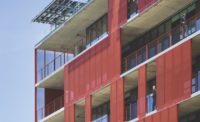Architecture 2030 Launches ‘Zero Code’ Standard

Installing enough PV capacity onsite to achieve net zero can be extremely challenging for buildings in urban environments. To meet electricity demand at the Bullitt Center in Seattle, the design team extended the 242-kilowatt rooftop array over the public right of way—a move that required special permission from the city.
Photo © Nic Lehoux

Image courtesy Architecture 2030


In mid-April, Architecture 2030, a non-profit organization that aims to make the building sector part of the solution for global warming, released a “Zero Code”—guidelines support the creation of zero net carbon buildings by combining efficiency standards with protocols for renewable energy. The aim is to reverse the upward trend in the built environment’s greenhouse gas emissions, which have been rising by nearly 1 percent per year since 2010. “We’ve got to begin to bend that curve downward,” says Ed Mazria, Architecture 2030’s founder and CEO.
A zero net energy building is one in which the total amount of energy used, on an annual basis, is equal to the amount of energy created on-site from renewable sources. But a building can qualify as zero net carbon—the focus of the Zero Code—by satisfying its annual energy demand from renewable sources that are located either on- or off-site.
Mazria contends that the new guidelines are especially relevant for cities where most current construction is concentrated. There is rarely sufficient roof space or correctly oriented and unshaded facade area in dense urban environments suitable for solar panels—the most common on-site energy source for zero net aspiring projects.
The Zero Code, which applicable to commercial and institutional buildings and mid- to high-rise housing, incorporates the latest version of the widely referenced energy standard ASHRAE 90.1 for its minimum efficiency requirements. This approach is intended to allow cities, states, and other jurisdictions to easily adopt the guidelines, either as an incentive program or as a compulsory provision of the building code.
Some observers say that the efficiency baseline should be more ambitious. “There are standards that are more stringent than 90.1,” says Mark Frankel, technical director with the New Buildings Institute, another non-profit whose goal is improving the performance of buildings. (The group frequently collaborates with Architecture 2030.) If the bar were set higher, says Frankel, projects would have to buy less off-site renewable energy in order to achieve zero net carbon status.
Other aspects of the Zero Code are its energy calculation software and a technical support document to help evaluate the various options for purchasing renewable power. Among the many possible procurement methods are direct ownership of a remote generation source, renewable energy investment funds, and renewable energy credits—all of which have different practical and environmental implications. Making sense of this “confusing space” for design teams, owners, and other stakeholders is the Zero Code’s main contribution, says Frankel. “It provides a way think about renewables, whether they are on the building or elsewhere, in a larger context.”







